Table of Contents |
It is important that the project manager is frequently monitoring the schedule. A project schedule must be updated often and the status of the schedule must be reported to the stakeholders and the team.
For the project manager to gain the information they need on the project's progress, team members must report on the time or effort spent on assigned tasks. The project manager can then compare the project actuals, such as time spent, to the project estimates created during the planning phase.
EXAMPLE
Below is a time sheet report that shows the actual effort on a task to test email operations for a mobile email application, and the estimates on the task from the planned schedule.| Daily Time Sheet | |||||
| Project | Tasks | Estimated Time | Estimated Effort | Actual Effort | Percent Complete |
|---|---|---|---|---|---|
| Mobile Email | Test Email Operations | 2 weeks | 40 hours | 20 hours | 60% |
There are two ways a team member can record the actual time spent on a task.
Reports on percentage complete can be highly subjective, though. Experienced workers will be able to estimate the amount of work done better than inexperienced workers, for example. It will be up to the project manager to account for these discrepancies.
To compensate for the subjectivity, the project manager can make the following comparisons:
IN CONTEXT
Suppose a task was 50% complete, but the hours spent in effort was already equal to the hours estimated for the task.
Daily Time Sheet Project Tasks Estimated Time Estimated Effort Actual Effort Percent Complete Mobile Email Test Email Operations 2 weeks 40 hours 40 hours 50%
A solution might be resource realignment, which may result in a team member spending more time and effort on a task with the goal of meeting time and percentage check marks.
Another option is bringing on a new individual to help complete the task.
In some cases, scope may need to be reduced for the work. In that case, stakeholders would need to be involved in the decision.
Organizations will have different requirements for the frequency by which status on tasks are tracked, the methods used to track the schedule, and the frequency that status reports are created about the schedule. When a project is behind schedule, more frequent updates may be required.
While monitoring a schedule, the project manager must always be aware of impacts to the critical path. The critical path is the longest chain of sequential dependent tasks on the project. This indicates how long a project will take to complete.
Since the critical path defines the end-date for the project, it's essential to monitor and manage the tasks on this path closely. Tracking the progress of project tasks to determine if actual completion is on target is known as task completion monitoring.
Tasks not on the path should also be managed, so as not to impact the tasks on the path.
IN CONTEXT
We have a project to develop a new customer complaint form for a website. The critical path diagram might look like this.

The longest sequential path through the project is 13 days. It's not a good idea to take resources from critical path tasks to assist with non-critical path tasks.
For example, unless the task to write user instructions takes longer than 13 days, it will not impact the critical path. However, if the design form task takes seven days instead of five days though, the critical path is impacted and does increase by two days also.

Assume that you take action to bring the schedule back in line with the original overall time estimate. You do this by adding resources to the program form task to drop the time to complete the work to three days, instead of five days. The network diagram would then look like this, and we would be back to 13 days for our critical path and our overall project time.

If project overruns continue to occur, a project manager might need to recommend changes to the project scope in order to bring the project back into alignment with the schedule. This is done through change management.
Source: This work adapted from Sophia Author Jeff Carroll.